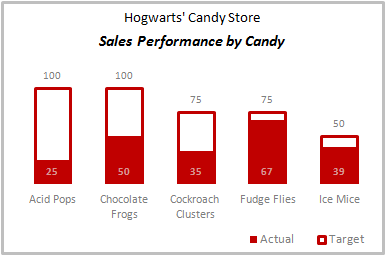Comparing values is one of the reasons why we make charts. So today I am going to teach you a handy little trick to make a thermometer like chart to compare targets with actuals. This type of chart is very useful when you have a bunch of sales targets and you want to measure how the performance has been. [Read excel theremometer charts for another option.]

To make a thermometer chart, just follow these 5 simple steps.
1. Select the data and make a column chart

Select the data and insert a column chart.

2. Select a chart data series and adjust “overlap” to “100% overlapped”

This will ensure that one series of the chart is 100% overlapped with another.

3. Format the target series so that only outline is shown
Select the series and set fill color to none, set the border color same as the fill color of “actual” series.

4. Remove grid lines and add data labels
Now our chart looks more like a thermometer.

5. Now go figure out why Acid Pops are struggling to sell
Yep, that is the fifth step. Go figure out why the targets are not met.
Bonus tip: If sometimes actual values are more than targets, then you should try different colors for target series’ border and actual series fill, like this:

Download chart template and compare 2 sets of values easily
Click here to download the excel file and use thermometer chart template.
How do you compare values?
Share your techniques and charting ideas using comments. Tell us how you compare values.
Additional tutorials & material:
Compare actual values with targets using excel and other excel charting tutorials. Also check out our section on excel dashboards.




















